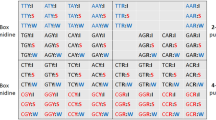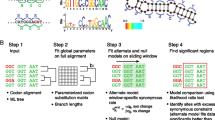Summary
The genomes of human viruses herpes simplex 1 (HSV1) and varicella zoster (VZV), although similar in biology, largely concordant in gene order, and identical in many amino acid segments, differ widely in their genomic G+C (abbreviated S) content, which is high in HSV1 (68%) and low in VZV (46%). This paper analyzes several striking codon usage contrasts. The S difference in coding regions is dramatically large in codon site 3, S3, about 42%. The large difference in S3 is maintained at the same level in a subset of closely similar genes and even in corresponding identical amino acid blocks. A similar difference in S levels in silent site 1 (S1) is found in leucine and arginine. The difference in S3 levels occurs in every gene and in every multicodon amino acid form. The S difference also exists in amino acid usage, with HSV1 using significantly more codon types SSN, while VZV uses more codon types WWN (where W stands for A or T). The nonoverlapping and narrow histograms of S3 gene frequencies in both viruses suggest that the difference has arisen and been maintained by a process of selective rather than nonselective effects. This is in sharp contrast to the relatively large variance seen for highly similar genes in the human versus yeast analysis. Interpretations and hypotheses to explain the HSV1 vs VZV condon usage disparity relate to virus-host interactions, to the role of viral genes in DNA metabolism, to availability of molecular resources (molecular Gause exclusion principle), and to differences in genomic structure.
Similar content being viewed by others
References
Baer R, Bankier AT, Biggin MD, Deininger PL, Farell PJ, Gibson TJ, Hatfull G, Hudson GS, Satchwell SC, Séguin C, Tuffnell PS, Barell BG (1984) DNA sequence and expression of the B95-8 Epstein-Barr virus genome. Nature (London) 310:207–211
Bernardi G, Bernardi G (1986) Compositional constrints and genome evolution. J Mol Evol 24:1–11
Bernardi G, Olofsson B, Filipski J, Zerial M, Cuny G, Meunier-Rotival M, Rodier F (1985) The mosaic genome of warmblooded vertebrates. Science 228:953–957
Bernardi G, Mouchiron D, Gautier C, Bernardi G (1988) Compositional patterns in vertebrate genomes: conservation and change in evolution. J Mol Evol 28:7–18
Bird AP (1986) CpG-rich islands and the function of DNA methylation. Nature (London) 321:209–213
Chee MS, Barrell BG (1990) Herpesviruses: a study of parts. Trends Genet 6:86–91
Chee MS, Bankier AT, Beck S, Bohni R, Brown CM, Cerny R, Horsnell T, Hutchison CA III, Kouzarides T, Martignetti JA, Preddie E, Satchwell SC, Tomlinson P, Weston KM, Barrell BG (1990) Analysis of the protein coding content of human cytomegalovirus strain AD 169. Curr Top Microbiol Immunol 154:125–169
Comings DE (1978) Mechanisms of chromosome banding and implications for chromatin structure. Ann Rev Genet 12: 25–46
Croen KD, Ostrove JM, Dragovic LJ, Straus SE (1988) Patterns of gene expression and sites of latency in human nerve ganglia are different for varicella-zoster and herpes simplex viruses. Proc Natl Acad Sci USA 85:9773–9777
Davison AJ (1984) Structure of the genome termini of varicella zoster virus. J Gen Virol 65:1969–1977
Davison AJ, McGeoch DJ (1986) Evolutionary comparisons of the S segments in the genomes of herpes simplex virus type 1 and varicella-zoster virus. J Gen Virol 67:597–611
Davison AJ, Scott JE (1986) The complete DNA sequence of varicella-zoster virus. J Gen Virol 67:1759–1816
Filipski J (1987) Correlation between molecular clock ticking, codon usage, fidelity of DNA repair, chromosome banding and chromatin compactness in gemline cells. FEBS Lett 217: 184–186
Filipski J, Salinas J, Rodier F (1987) Two distinct compositional classes of vertebrate gene-bearing DNA stretches, their structures and possible evolutionary origin. DNA 6:109–118
Gompels UA, Craxton MA, Honess RW (1988) Conservation of gene organization in the lymphotopic herpesviruses, herpesvirus saimiri and Epstein-Barr virus. J Virol 62:757–767
Grantham R, Gautier C, Gouy M, Jacobzone M, Pave A (1981) Codon catalog usage in a genome strategy modulated for gene expressivity. Nucleic Acids Res 8:r49–62
Grosjean H, Fiers W (1982) Preferential codon usage in prokaryotic genes: the optimal codon-anticodon interaction energy and the selective codon usage in efficiently expressed genes. Gene 18:199–209
Gutman GA, Hatfield GW (1989) Nonrandom utilization of codon pairs inEscherichia coli. Proc Natl Acad Sci USA 86: 3699–3703
Holmquist GP (1989) Evolution of chromosome bands: molecular ecology of noncoding DNA. J Mol Evol 28:469–486
Honess RW (1984) Herpes simplex and ‘the Herpes complex’: diverse observations and a unifying hypothesis. J Gen Virol 65:2077–2107
Honess RW, Bodemer W, Cameron KR, Niller H-H, Fleckenstein B (1986) The A+T-rich genome of herpesvirus saimiri contains a highly conserved gene for thymidylate synthase. Proc Natl Acad Sci USA 83:3604–3608
Honess RW, Gompels UA, Barrell BG, Craxton M, Cameron KR, Staden R, Chang N-Y, Hayward GS (1989) Deviations from expected frequencies of CpG dinucleotides in herpesvirus DNAs may be diagnostic of differences in the states of their latent genomes. J Gen Virol 70:837–855
Ikemura T (1981) Correlation between the abundance ofEscherichia coli transfer RNAs and the occurrence of the respective codons in its protein genes: a proposal for a synonymous codon choice that is optimal for theE. coli translational system. J Mol Biol 151:398–409
Ikemura T (1985) Codon usage and tRNA content in unicellular and multicellular organisms. Mol Biol Evol 2:12–34
Jukes TH, Bhushan V (1986) Silent nucleotide substitutions and G+C content of some mitochondrial and bacterial genes. J Mol Biol Evol 24:39–44
Karlin S, Morris M, Ghandour G, Leung M-Y (1988) Efficient algorithms for molecular sequence analysis. Proc Natl Acad Sci USA 85:841–845
Karlin S, Ost F, Blaisdell BE (1989) Patterns in DNA and amino acid sequences and their statistical significance. In: Waterman MS (ed) Mathematical methods for DNA sequences. CRC Press, Boca Raton FL, pp 133–157
Karlin S, Blaisdell BE, Schachtel GA (1990a) Contrasts in codon usage of latent versus productive genes of the Epstein-Barr virus: data and hypotheses. J Virol 64:4264–4273
Karlin S, Blaisdell BE, Brendel V (1990b) Identification of significant patterns in proteins. Methods Enzymol 183:388–402
Kimura M (1983) The neutral theory of molecular evolution, chapters 8, 9. Cambridge University Press, Cambridge
Lawrence GL, Chee M, Craxton MA, Gompels UA, Honess RW, Barrell BG (1990) Human herpesvirus 6 is closely related to human cytomegalovirus. J Virol 64:287–299
Leung MY, Blaisdell BE, Burge C, Karlin S (1991) An efficient algorithm for identifying matches with errors in multiple long molecular sequences. J Mol Biol 221: in press
McGeoch DJ (1989) The genomes of the human herpesviruses. Ann Rev Microbiol 43:235–265
McGeoch DJ, Doland A, Donald S, Brauer DHK (1986) Complete DNA sequence of the short repeat region in the genome of herpes simplex virus type 1. Nucleic Acids Res 14:1727–1745
McGeoch DJ, Dalrymple MA, Davison AJ, Dolan A, Frame MC, McNab D, Perry LJ, Scott JE, Taylor P (1988) The complete DNA sequence of the long unique region in the genome of herpes simplex virus type I. J Gen Virol 69:1531–1574
Quinlan MP, Knipe DM (1983) Nuclear localization of herpesvirus proteins: potential role for the cellular framework. Mol Cell Biol 3:315–324
Roizman B (1990) Herpesviridae: a brief introduction. In Virology, 2nd edition, Fields BN and Knipe DM (eds), Raven Press, NY, pp 1787–1793
Roughgarden J (1979) Theory of genetics and evolutionary ecology: an introduction. MacMillan, New York
Shapiro SH (1976) Distribution of purines and pyrimidines in deoxyribonucleic acids. In: Fasman GD (ed) Handbook of biochemistry and molecular biology, ed 3. Nucleic acids, vol 2. CRC Press, Cleveland OH, pp 241–283
Shapaer EG (1986) Constraints on codon context inEscherichia coli genes; their possible role in modulating efficiency of translation. J Mol Biol 188:555–564
Smith TF, Ralph WW, Goodman M, Czelusniak J (1985) Codon usage in the vertebrate haemoglobins and its implications. Mol Biol Evol 2:390–398
Straus SE (1989) Clinical and biological differences between recurrent herpes simplex virus and varicella zoster virus infection. J Am Med Assoc 262:3455–3458
Sueoka N (1988) Directional mutation pressure and neutral molecular evolution. Proc Natl Acad Sci USA 85:8305–8309
Tazi J, Bird A (1990) Alternative chromatin structure at CpG islands. Cell 60:909–920
Trimble JJ, Murthy SCS, Bakker A, Grassmann R, Desrosiers RC (1988) A gene for dihydrofolate reductase in a herpesvirus. Science 239:1145–1147
Yarus M, Foley LS (1985) Sense codons are found in specific contexts. J Mol Biol 182:529–540
Author information
Authors and Affiliations
Rights and permissions
About this article
Cite this article
Schachtel, G.A., Bucher, P., Mocarski, E.S. et al. Evidence for selective evolution in codon usage in conserved amino acid segments of human alphaherpesvirus proteins. J Mol Evol 33, 483–494 (1991). https://doi.org/10.1007/BF02102801
Received:
Revised:
Accepted:
Issue Date:
DOI: https://doi.org/10.1007/BF02102801




